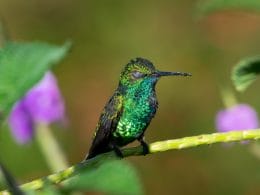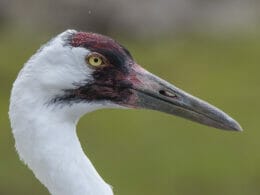Among five of a bird’s senses, sight is arguably the most important. With around 10,000 individual bird species in the world, each with different levels of vision, it’s hard to estimate just how good their eyesight truly is. We often see them graciously flying during the daylight, but how about in the dark? Can birds see at night, and if so, how?
The short answer to this question is yes, birds can see at night. Most birds, like owls, bat hawks, and frogmouths, have excellent night vision. They can hunt and fly in the dark easily. However, like cats, they can’t see in complete darkness.
In this post, we’ll explain everything you need to know about bird vision, including extraocular anatomy, light perception, and everything in between.
Anatomy of a Bird’s Eye
Most birds share the same eye anatomy. Like humans, their eyes are made up of several sections: lens, cornea, and retina. More often than not, bird eyes are a lot larger than human eyes. For instance, the biggest bird in the world—Ostriches—have eyes that are almost twice as big as a regular human eye. Songbirds have eyes that are often as large as their brains!
Unlike those that belong to mammals, bird eyes more closely resemble that of a reptile. They aren’t spherical like ours are; instead, they have a flatter shape that enables birds to focus on a visual field easily. Their lenses are pushed further forward, too, thus increasing the size of the retina’s image.
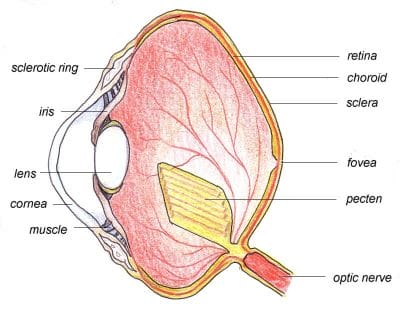
Author Note: The wall of the eyeball consists of three layers. This includes the cornea and sclera, which are found in the outer layer, the vascular cells in the middle layer, and the nervous retinal layer in the inner part.
Because their pupils are so large, more light enters the eye. That’s what allows them to see in dimmer light. Plus, the cells inside their retinas—the fovea—comes with approximately 400,000 photoreceptor cones per square millimeter. For context, humans have only approximately 200,000. So, it isn’t much of a surprise that birds can see in much sharper detail than we do.

Unique Visual Optics That Birds Possess
Compared to humans, birds have a remarkable color perception. Birds are what we call tetrachromats, meaning they can see in four colors: UV, blue, green, and red. On top of that, they’re also equipped with high UV-A sensitivity. In comparison, we are trichromats; we only see blue, green, and red.
UV Vision
Birds process a broader wavelength spectrum than humans, ranging from 300 to 400 nm.
This ability isn’t unique only to birds, as several fish, amphibians, and reptiles also have this capability. However, evidence suggests that their UV-vision provides them with evolutionary advantages over any other creature.
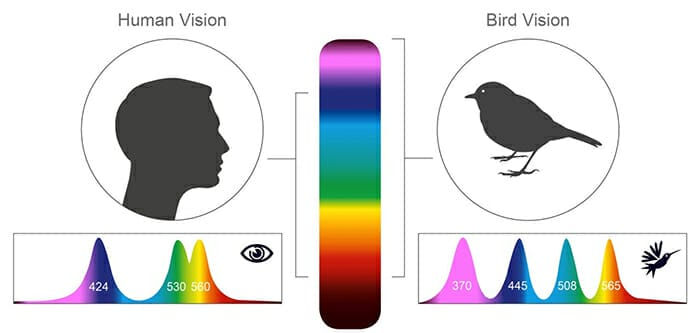
UV vision allows birds to easily spot insects, mammals, berries, and eggs during the flight from miles away, even in the dark. Also, they can see colors that are near to entirely invisible to humans. On top of that, UV vision allows them to easily differentiate a monomorphic bird’s sex for the purpose of mating.
Color Perception
Birds have a type of sensory perception that allows them to detect location, direction, or altitude called magnetoreception. They use this sense to orient themselves at night when there is minimal light or if their vision worsens.
Furthermore, research indicates that birds can see plane-polarized light, which is a sort of built-in magnetic compass that shifts when minimal amounts of light are absorbed. They use the same photoreceptors that detect color to detect the difference between location and altitude. Many believe that this function also affects how they see colors.
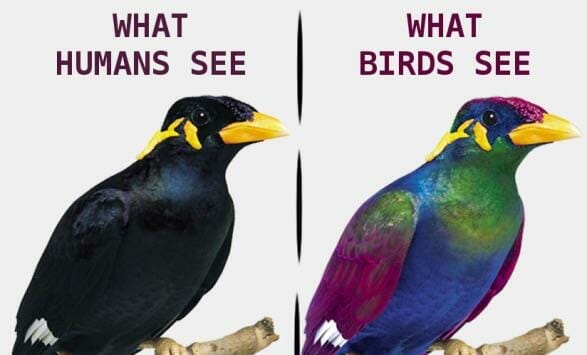
Motion Detection
As birds evolved to move faster, the unit of frequency in which they see has also increased. Compared to humans, where we can see about 60Hz during continuous movements, birds can see up to twice as much at 100Hz.
It’s also said that most prey birds have twice the amount of fovea than predator birds do. This allows them to keep track of moving objects much easier. Interestingly, pigeons have the ability to detect movement as slow as 15 degrees per hour.
Sight Difference Between Diurnal and Nocturnal Birds
Birds are either diurnal or nocturnal. Diurnal birds, like parrots, hummingbirds, and woodpeckers, are most active during the day. Nocturnal birds, similar to nighthawks, night-herons, and of course owls, are almost always active during the night.
Nocturnal birds possess a pathway through which rods connect to the same “dark” circuits used by cones. These rods are what significantly help with night vision. It also gives them a better perception of movement, edges, and silhouettes in dim light.
Nocturnal birds hunt, forage, and care for their young during the darkest night hours.

In comparison, diurnal birds have more cones and fewer rods. Although they’re not entirely blind in the dark, their night vision is quite limited compared to nocturnal birds. Still, they can see much better than we can in the dark. For example, Geese can see up to 12 times better at night than we can—and they’re diurnal birds.
A large number of birds sleep during the night. They shelter in high trees, cavities, or niches. On particularly cold nights, they might huddle close together to keep warm. Other birds, such as ducks and geese, float on top of the water while sleeping.
Ostriches sleep standing up with their eyes open, similar to herons and flamingos. No, they don’t bury their heads in the sand, contrary to popular belief!
Night Activities Diurnal Birds Partake In
Despite the clear division between diurnal and nocturnal birds, there are several activities that both do at times. This includes singing, migration, and even dancing.
Night Singing
Author Note: Most birds sing at night to warn others of their territory. They often do this at night because there is less ambient noise, which therefore allows their calls to be heard at much greater distances.
Other than territorial calls, birds sing at night to attract mates. Scientists have concluded that quite a large number of species, including Song Sparrow and House Finch, perform these nightly rituals. You’ll often see birds doing these calls in areas with artificial light or under the bright moon.
Night Migration
In order to steer clear of predators and bigger birds, a number of diurnal birds prefer migrating during the night. This greatly helps smaller birds avoid contact with dangerous airborne predators. They use stars for navigating and choose days where the air is less turbulent.
Sky Dancing
Sky dancing is similar to night singing. On spring evenings, male birds, particularly American Woodcocks and Starlings, perform an elaborate territorial display wherein they circle higher and higher in the air before plummeting back to the ground.
They do this dance throughout the night. After dancing, male woodcocks establish their favorite place and start enticing female birds by singing as loud as they can. This activity can go on all night, from sunset to sunup. It’s quite the sight to behold.

Monocular vs. Binocular Vision
The primary difference between monocular and binocular vision is the location of the bird’s eyes.
Birds with binocular vision, including owls and eagles, have eyes that are located in front of their heads. Similar to that of humans.
On the other hand, birds with monocular vision have eyes that can focus on two different objects at any given moment. This means that they not only see what’s in front of them but everything around them at the same time, as well.
Author Note:This gives them an increased field of view. The only downside to this is that their depth perception is compromised, which is why we often see birds having trouble distancing themselves from one object to another.
Examples of monocular birds are pigeons and parrots. Because they have a larger field of vision than binocular birds, they can easily see a predator trying to sneak upon them.

Binocular vision birds like owls and eagles can see depth and distance more clearly than monocular birds since both eyes can focus on the same object simultaneously. This is why they’re such brilliant predators; they can easily spot small prey even while extremely high up in the air.
Bottom Line
Can birds see at night? Yes, they can, arguably even better than any type of animal species.
Nocturnal birds can see better than diurnal birds at night because they have a lot more rod cells than the latter. This makes them increasingly sensitive to light. On the other hand, diurnal birds have more cones than they have rods, preventing them from seeing in complete darkness.
Decades of research prove that birds, without a doubt, see better at night than we do. So, if you’re worried about your favorite woodpecker or pigeon getting lost in the dark, don’t be! You can rest assured that they’ll make their way to safety just fine.
Fly high friends!
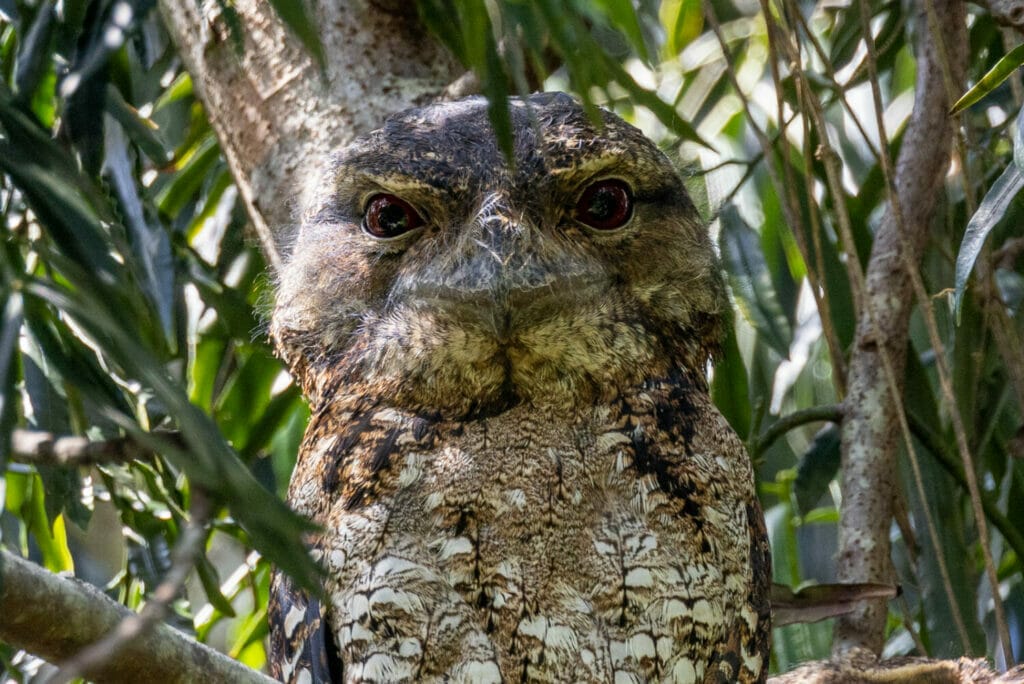
FAQ
This expression means you have a wide view of an area (or topic) and can see all the details.
Surprisingly it is not the owl. This is a different question. Eagles have 20/5 vision which means, in simple terns, their vision is 4 times sharper than that of a human.
Yes, they do. The can close them as we would expect, although it might be in a different manner. They also have and extra eyelid called a nictitating membrane. It is a thin, skin lie structure that protects the eye from debris or water.









